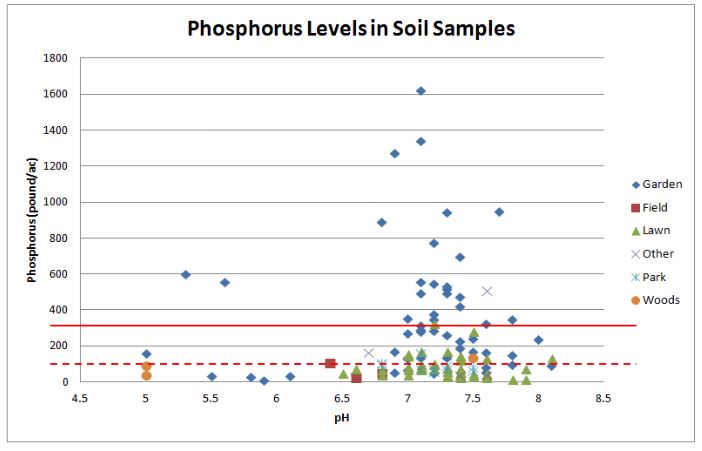
This report is provided by Watersheed Coordinator Abbey Tobe:

The Lawn and Garden Soil Sample program ended on November 21, 2014. 124 samples were sold this year. Soil test information included pH, percent organic matter, phosphorus levels, potassium levels, magnesium levels, calcium levels, and the Cation Exchange Capacity. Helena recommends programs and nutrient additives to help balance soil levels.
At the present, phosphorus is the suspect nutrient. The above graph plots the phosphorus values against pH values. Some research suggests that there might be a correlation between pH and dissolved phosphorus levels. However, here, phosphorus is plotted against pH to help scatter out the data. The important piece to take away from the above plot is the location the soil sample was taken. While not conclusive or representative, it is interesting that most of the higher phosphorus levels are found in garden samples. A lot of focus has been on lawn fertilizer. We need to continue to keep tabs on the “what, where, when, and how much” of lawn fertilizers used, but let’s not forget about the gardens because, after all, they are tiny fields surrounded by filter strips.
The following percentages are based on the limit of 300 pounds/acre (denoted by the red line on the graph).
This is the threshold currently used for agriculture. Above 300 pounds/acre, no manure is allowed to be applied to fields. Keeping everyone on this same system, 21% of the samples exceed the limit of 300 pounds/acre. 92% of the exceeded samples were taken from garden locations.
Let’s look at the numbers if we drop that threshold to 100 pounds/acre (denoted by dashed line). 62 of the 124 samples tested at greater than 100 pounds P/acre. That’s 50%. Another five samples were within the 90-99 pound/acre range. This means that a significant portion of the ground sampled around the county does not need phosphorus. These results are used for the benefit of the individual. It is important to do your individual part in improving water quality and soil health.
This program is a joint effort between the Lake Improvement Association, Helena Agronomic Center, and Grand Lake/Wabash Watershed Alliance. The 2015 soil testing season will begin around April/May of next year, weather permitting.
